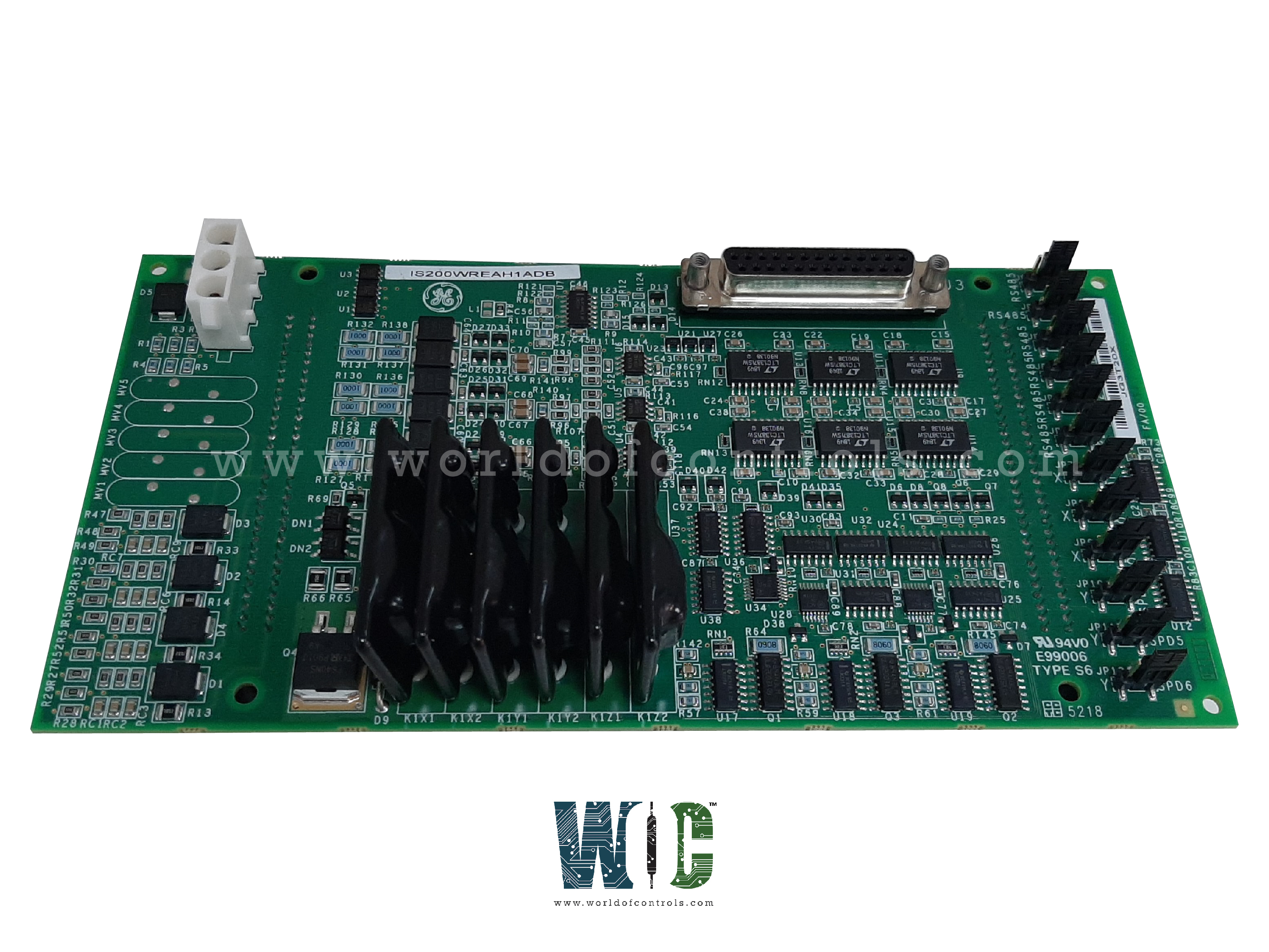SPECIFICATIONS
Part No.: IS200WREAH1ADB
Manufacturer: General Electric
Country of Manufacture: United States of America (USA)
Temperature: -30 to 65oC
Technology: Surface-mount
Product Type: Aero Trip Terminal Board
Availability: In Stock
Series: Mark VIe
Functional Description
IS200WREAH1ADB is a Aero Trip Terminal Board developed by GE. It is a part of Mark VIe control system. The Mark VIe control system stands as a versatile and robust solution meticulously engineered to cater to an extensive spectrum of control and protection applications within the realm of power generation and industrial processes. Its adaptability and functionality extend across a diverse array of systems, from steam and gas turbines to the broader landscape of power generation's balance of plant (BoP) equipment.
Operating Environment
- The preferred location for housing the Mark VIe control system cabinet is within an environmentally controlled room or the control room itself. Placing the cabinet in such a controlled environment ensures optimal operating conditions for the system's components and electronics. It's essential that the mounting of the cabinet occurs on a floor surface that allows attachment in a single plane, ensuring stability, alignment, and proper functioning of the equipment. Customers are typically responsible for providing the necessary hardware to securely affix the cabinet.
- For installation or relocation, lifting lugs are provided on the cabinet. If employed, lifting cables must adhere to an angle not exceeding 45° from the vertical plane, ensuring safe handling and positioning without causing damage to the cabinet or its contents.
- The cabinet is designed with security in mind, featuring a door handle that can be locked, safeguarding the sensitive equipment housed within from unauthorized access.
- To facilitate the interconnection of cables, the cabinet incorporates removable access plates, enabling the routing of cables from either the top or bottom. However, it's crucial that when using convection cooling methods, any conduits utilized for cable entry are properly sealed to the access plates. This sealing ensures the maintenance of the controlled internal environment necessary for effective convection cooling. Additionally, any air passing through these conduits must be within the acceptable temperature range specified for the system's components. This guideline applies to both the top and bottom access plates to maintain consistent and optimal operating conditions inside the cabinet.
Fiber-Optic Converter Features
- A Fiber-Optic Converter is an indispensable component utilized within communication systems, especially in scenarios where fiber-optic connections need integration or conversion with different signal types. Typically, fiber-optic connections terminate at the 100BaseFX fiber port of an Ethernet switch, offering high-speed and reliable data transmission over long distances with minimal signal degradation.
- In certain instances, the Mark VIe communication system, a prevalent system in industrial automation, might necessitate an Ethernet media converter. This converter serves the crucial function of translating selected UDH (Unidirectional Data Highway) and PDH (Parallel Data Highway) electrical signals into fiber-optic signals, facilitating seamless integration and communication within the system.
- The standard operation of a media converter involves bidirectional conversion, where one or more Ethernet 100BaseTX signals, transmitted through copper cables, are converted to Ethernet 100BaseFX signals compatible with fiber-optic infrastructure. This conversion process ensures interoperability between different types of Ethernet signals, enabling the integration of devices and systems operating on disparate communication mediums.
- These media converters play a pivotal role in ensuring connectivity and compatibility within complex communication networks, allowing for the integration of devices that utilize varied signal transmission methods. By supporting bidirectional conversion, these converters enhance the flexibility and adaptability of communication systems, allowing data to flow seamlessly between Ethernet networks utilizing copper wiring and those relying on fiber-optic connections.
- Furthermore, the deployment of media converters offers scalability and versatility to communication infrastructures. They enable the expansion of network capabilities by bridging the gap between different signal types, optimizing connectivity, and fostering efficient data transmission across diverse communication mediums.
- Overall, the Fiber-Optic Converter, in its role as an Ethernet media converter, serves as a crucial intermediary, facilitating the seamless conversion and integration of Ethernet signals from copper-based transmission to fiber-optic communication. This capability ensures the smooth operation and interconnectivity of various devices and systems within the Mark VIe communication network, enhancing overall efficiency and reliability in industrial automation applications.
The WOC team is always available to help you with your Mark VIe requirements. For more information, please contact WOC.
Frequently Asked Questions
What is IS200WREAH1ADB?
It is a Aero Trip Terminal Board developed by GE under the Mark VIe series.
What is a Fiber-Optic Converter, and where is it commonly used?
A Fiber-Optic Converter is an essential component used in communication systems, especially in scenarios requiring integration or conversion between fiber-optic connections and different signal types.
How do fiber-optic connections typically terminate in communication systems?
Fiber-optic connections usually end at the 100BaseFX fiber port of an Ethernet switch. They offer high-speed, reliable data transmission over long distances with minimal signal degradation.
